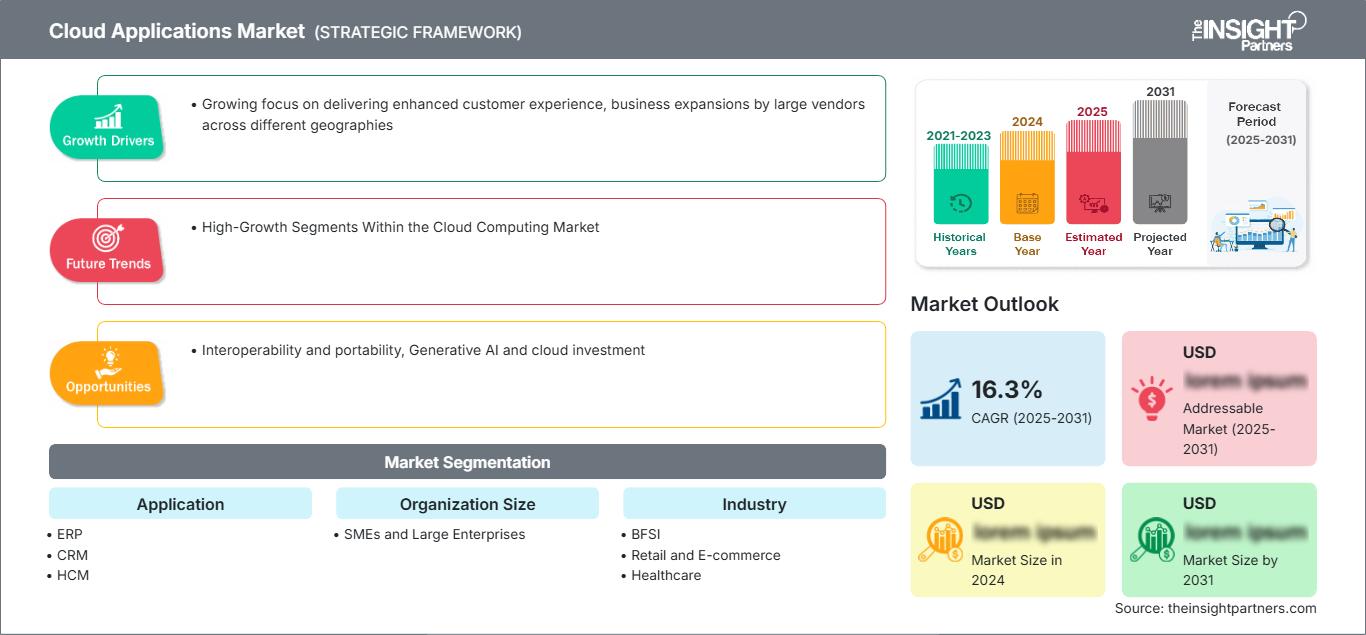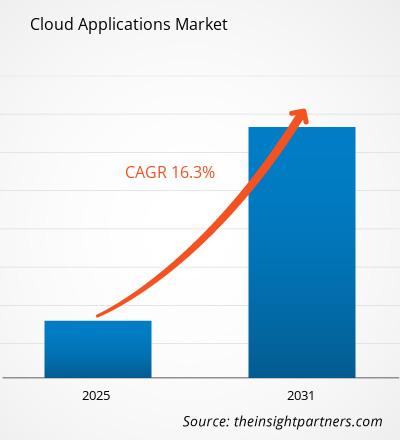页面已更新 :
Aug 2024
预计 2023 年至 2031 年期间,云应用市场的复合年增长率将达到 16.3%。互操作性和可移植性以及生成式人工智能和云投资可能仍将是市场的主要趋势。
云应用市场分析
- 云应用已在不同行业甚至组织中得到广泛应用。全球近 90% 的企业已采用云计算,并将云应用用于其业务运营。
- 从小型企业到大型企业,云应用的采用已变得非常普遍。组织正在感受云应用的脉搏,因为它们具有可扩展、经济高效、灵活且协作性强的特点。
- 因此,云应用已成为现代商业战略的一部分,使组织能够减少额外程序、提高生产力并在现代数字环境中保持竞争力。
云应用市场概览
- 云应用市场正在增长,潜力巨大,市场前景看好。云应用能够快速响应业务需求。企业可以按需快速更新、测试和部署应用,从而缩短上市时间并提升敏捷性。
- 同时,它通过云计算市场中高增长的细分市场(例如 SaaS 和混合云)为云应用市场创造了增长机会。这些细分市场吸引了各种规模的企业,并在应用开发、测试和部署方面不断创新。
- 对云基础设施的依赖程度不断提高以及对云原生平台的需求不断增长也推动了云应用市场的增长。总而言之,云应用市场的前景依然乐观,尤其是在提升客户体验、降低成本以及体验技术固有的灵活性和可扩展性方面。
自定义此报告以满足您的要求
您将免费获得任何报告的定制,包括本报告的部分内容,或国家级分析、Excel 数据包,以及为初创企业和大学提供超值优惠和折扣
云应用市场: 战略洞察

- 获取本报告的主要市场趋势。这个免费样本将包括数据分析,从市场趋势到估计和预测。
云应用市场驱动因素和机遇:日益注重提供增强的客户体验以利于市场发展
自定义此报告以满足您的要求
您将免费获得任何报告的定制,包括本报告的部分内容,或国家级分析、Excel 数据包,以及为初创企业和大学提供超值优惠和折扣
云应用市场: 战略洞察

- 获取本报告的主要市场趋势。这个免费样本将包括数据分析,从市场趋势到估计和预测。
- 日益注重提供增强的客户体验,推动了云应用市场的增长,强调了满足客户需求和提高客户满意度和忠诚度的重要性。
- 当企业更加关注客户体验时,他们会意识到云应用在实现这一目标方面的关键作用。云应用可以使企业实体更快地响应客户需求,更好地适应个人需求,从而与客户建立更紧密的关系。
- 企业现在正在使用技术来提供与云相结合的更好的业务关系,以开辟提供轻松、个性化和全渠道体验的新方式,满足现代客户的期望。因此,提供更佳的客户体验一直是云应用在市场上加速增长和普及的主要推动力。
云计算市场中的高增长细分市场
- 预计云计算市场的增长将由该行业的高增长细分市场推动。这些细分市场包括软件即服务、应用程序开发和测试、混合云等。这些细分市场正在快速发展,并将共同推动云计算市场的增长。
- 企业组织大量采用 SaaS 应用程序的原因是它们易于使用且易于部署。在这方面,应用程序开发和测试的工作量激增,尤其是在以下方面:云按需资源、扩展和协作工具。
- 此外,混合云解决方案的采用以及各行业向云部署的转型也蕴藏着巨大的增长机会。正是在云计算市场中的这些高增长细分市场中,云应用程序的增长和采用才开辟了道路,从而帮助企业利用云技术推动各自运营中的创新。
云应用程序市场报告细分分析
有助于得出云应用程序市场分析的关键细分市场是应用程序、组织规模和行业。
- 根据应用程序,云应用程序市场分为 ERP、CRM、HCM、SCM、内容管理、BI 和分析等。
- 根据组织规模,云应用程序市场分为 SME 和大型企业。
- 根据行业,云应用程序市场分为 BFSI、零售和电子商务、医疗保健、IT 和电信、石油和天然气、政府等。
按地区划分的云应用程序市场份额分析
- 云应用程序市场报告对五个主要地理区域进行了详细分析,其中包括当前以及2021年至2031年的历史市场规模和预测,涵盖北美、欧洲、亚太地区 (APAC)、中东和非洲 (MEA) 以及南美洲和中美洲。
- 每个地区进一步细分为相应的国家/地区。本报告提供对18个以上国家/地区的分析和预测,涵盖云应用市场动态,例如影响区域市场的驱动因素、趋势和机遇。
- 此外,本报告还涵盖了PEST分析,其中涉及研究影响这些地区云应用市场的主要因素。
云应用市场
The Insight Partners 的分析师已详尽阐述了预测期内影响云应用市场的区域趋势和因素。本节还讨论了北美、欧洲、亚太地区、中东和非洲以及南美和中美洲的云应用市场细分和地域分布。
云应用市场报告范围
| 报告属性 | 细节 |
|---|---|
| 市场规模 2024 | US$ XX million |
| 市场规模 2031 | US$ XX Million |
| 全球复合年增长率 (2025 - 2031) | 16.3% |
| 历史数据 | 2021-2023 |
| 预测期 | 2025-2031 |
| 涵盖的领域 |
By 应用程序
|
| 覆盖地区和国家 | 北美
|
| 市场领导者和主要公司简介 |
|
云应用市场参与者密度:了解其对业务动态的影响
云应用市场正在快速增长,这得益于终端用户需求的不断增长,而这些需求的驱动因素包括消费者偏好的不断变化、技术进步以及对产品优势的认知度不断提高。随着需求的增长,企业正在扩展其产品线,不断创新以满足消费者需求,并利用新兴趋势,从而进一步推动市场增长。

- 获取 云应用市场 主要参与者概述
云应用市场评估通过收集一手和二手研究的定性和定量数据进行,这些数据包括重要的公司出版物、协会数据和数据库。云应用市场的一些发展如下:
- IBM 宣布已签署最终协议,收购 Advanced 的应用程序现代化能力,带来人才、工具和知识的结合,以增强 IBM Consulting 的大型机应用程序和数据现代化服务。此次计划中的收购将进一步使我们能够支持客户的大型机应用程序现代化之旅,标志着 IBM 的混合云和 AI 战略又向前迈出了重要一步。(来源:IBM,新闻稿,2024 年 1 月)
云应用市场报告内容和交付成果
“云应用市场规模和预测(2021-2031)”报告提供了涵盖以下领域的市场详细分析:
- 云应用市场规模以及涵盖范围内所有关键细分市场的全球、区域和国家/地区预测
- 云应用市场趋势以及市场动态,例如驱动因素、限制因素和关键机遇
- 详细的 PEST/Porter 五力模型和 SWOT 分析
- 云应用市场分析涵盖关键市场趋势、全球和区域框架、主要参与者、法规和最新市场发展
- 行业格局和竞争分析涵盖市场集中度、热图分析、知名参与者和云应用市场的最新发展
- 详细的公司简介
- 历史分析(2 年)、基准年、预测(7 年)及复合年增长率
- PEST和SWOT分析
- 市场规模、价值/数量 - 全球、区域、国家
- 行业和竞争格局
- Excel 数据集
近期报告
客户评价
购买理由
- 明智的决策
- 了解市场动态
- 竞争分析
- 客户洞察
- 市场预测
- 风险规避
- 战略规划
- 投资论证
- 识别新兴市场
- 优化营销策略
- 提升运营效率
- 顺应监管趋势
我们的客户































87-673-9708

ISO 9001:2015



 获取免费样品 - 云应用市场
获取免费样品 - 云应用市场